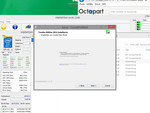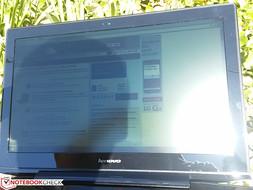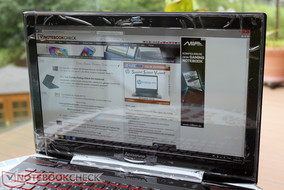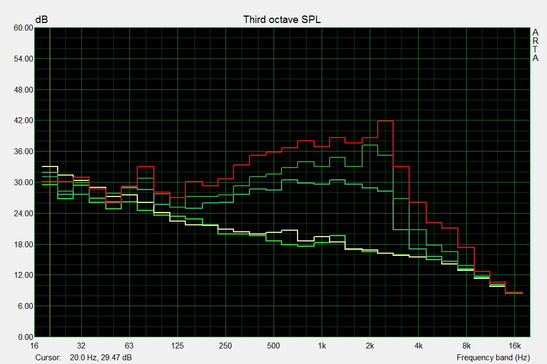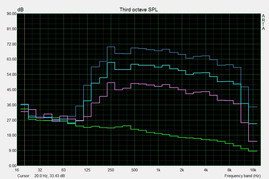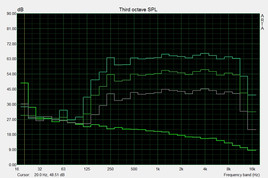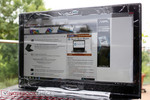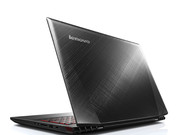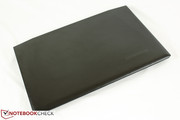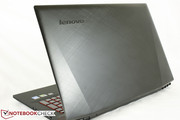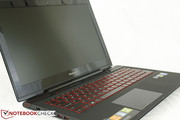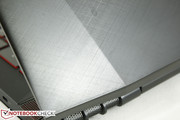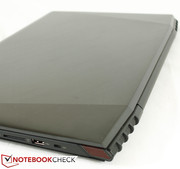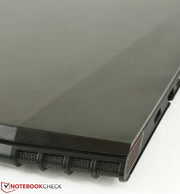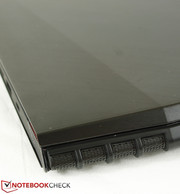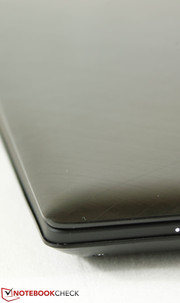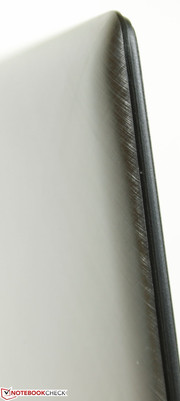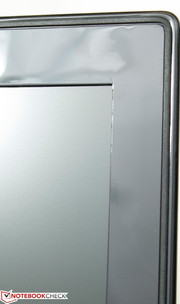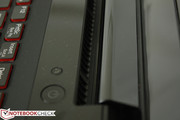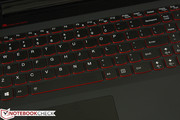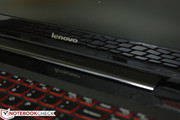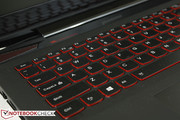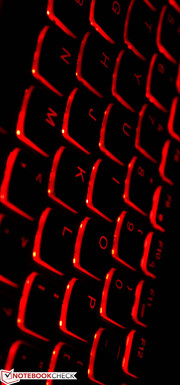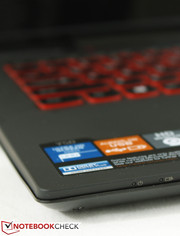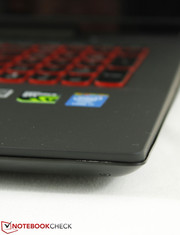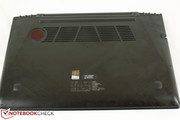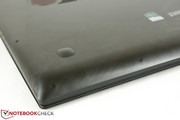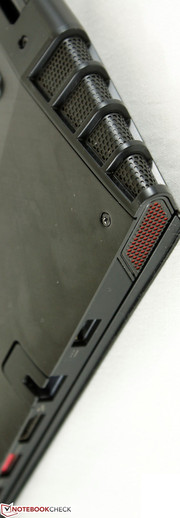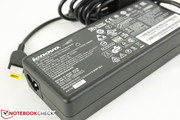Lenovo IdeaPad Y50-70 (59424712) Notebook Review Update

For the original German review, see here.
The Lenovo Y50 is one of the most interesting products in the 2014 portfolio of the Chinese hardware giant. The device is explicitly advertised as a gaming notebook, even though its design (15.6-inch, 4 kilograms, 24 millimeters height) and equipment (Intel Core i7-4710HQ, Nvidia GeForce GTX 860M, SSD) would allow it to be part of the high-performance multimedia segment. Probably it's exactly this balancing act that makes the device interesting for a large clientele. A lot of performance in a smart and mobile chassis at an attractive price. Sounds like a clear victory, there is, however, a catch...
In our first test of the Lenovo IdeaPad Y50-70 we went through a configuration for the US market, equipped with a Full HD display as offered in many shops in Germany. Our conclusion: great package, but disappointing display with low brightness and contrast, not to mention the poor color accuracy and the limited viewing angles. Looking at the aggressive entry level price of only 899 Euros, ~$1181 (i5-4200M, 860M), we immediately find the explanation for that extremely bad panel.
Starting from 1399 Euros, ~$1838 (1199 Euros, ~$1575, without operating system), the UHD display we are focusing on with a resolution of 3840x2160 pixels is used. The large price difference to the entry-level configuration is explained by the Intel i7-4710HQ quad-core CPU and a 512 GB SSD. In the following review we are dealing with the differences to the already tested version. Further information on the identically constructed chassis can be retrieved from the existing test of the Lenovo Y50-70 with FHD display.
Communication
Contrary to the first tested version of the Lenovo IdeaPad Y50, which is equipped with an Intel wireless AC3160, the top configuration for the German market is equipped with an Atheros module (AR9565 b/g/n). We performed a comparative test with three other devices.
It became apparent that the integrated Wi-Fi solution does not count among the most performant connections. At the first reading point (around 5 m distance from the router, two small interior walls), the entire possible range was available. Already at the second reading point (distance of around 15 m to the router, 4 small interior walls, glass door), the connection collapsed and simple browsing was hardly possible anymore. It came as no surprise that at the last reading point (distance of 15 m, 2 brick sub-ceilings), connection collapsed regularly. The best run out of 3 was noted down.
Display
After the arms race of higher gigabyte and gigahertz levels of recent years, now the display is in the spotlight of the manufacturer and its marketing department. That the stupid push up of pixels matters here first, as our "common sense" tells us that 3840x2160 pixels just have to be better (!) than the antiquated 1920x1080 pixels, comes as no surprise. Next to resolution, a display also has other qualities (or not) that we are focusing on now.
The offered pixel density of a high 284 pixels per inch assures a pin-sharp image of all scalable vector contents. This stands out positively for texts that are still readable at even small font sizes and a small distance from the display, and that still show sharp contours. Of course, image and video material could profit from such detail abundance, but corresponding video material is not available yet on a large scale. As already mentioned in many of our tests of high-resolution displays, one often has to put up with representation errors, especially for older software tools that cannot be scaled appropriately.
An essential point of criticism of the alternative FHD display of the Y50 was its poor brightness. With a maximum of 237 cd/m2 it was only insignificantly higher than required for an entry-level notebook. The UHD panel already improved in this point. We measure a maximum of 290 cd/m2 in the central area at an average brightness of 257 Candela. The drop toward the edges, which is clearly visible in the diagram, results in an illumination of just 80%. In practice, however, no impairments could be observed. Only in a completely dark room with pure black background, a translucency of the background illumination (screen bleeding) could be observed in the upper right corner.
Choosing the right display is made even more difficult by the different panels that are available for the FHD version. Next to the already tested CMN15C4 (Chi Mei N1156HGE-EAB), an AU Optronics (AUO36ED) panel is used which our Polish colleagues found in their test of the Y50. With a brightness of 234 Candela on average and a contrast of only 275:1, it is still on a comparably bad level as the Chi-Mei alternative. On its homepage, Lenovo states that the UHD display is a touch display. However, the version that we tested (59424712) does not show any touch functionality.
Display Readings Y50-70 UHD Samsung FLLTN156FL02L01
| |||||||||||||||||||||||||
Brightness Distribution: 81 %
Center on Battery: 290 cd/m²
Contrast: 566:1 (Black: 0.512 cd/m²)
ΔE Color 3.72 | 0.5-29.43 Ø5
ΔE Greyscale 3.11 | 0.57-98 Ø5.3
48.16% AdobeRGB 1998 (Argyll 1.6.3 3D)
52.3% AdobeRGB 1998 (Argyll 2.2.0 3D)
76.3% sRGB (Argyll 2.2.0 3D)
50.6% Display P3 (Argyll 2.2.0 3D)
Gamma: 2.48
Display Readings Y50-70 FHD Chi Mei CMN15C4
| |||||||||||||||||||||||||
Brightness Distribution: 85 %
Center on Battery: 185.2 cd/m²
Contrast: 315:1 (Black: 0.722 cd/m²)
ΔE Color 10.13 | 0.5-29.43 Ø5
ΔE Greyscale 10.04 | 0.57-98 Ø5.3
34.26% AdobeRGB 1998 (Argyll 1.6.3 3D)
37.28% AdobeRGB 1998 (Argyll 2.2.0 3D)
52.8% sRGB (Argyll 2.2.0 3D)
35.98% Display P3 (Argyll 2.2.0 3D)
Gamma: 2.15
Display Readings Y50-70 FHD AU Optronics AUO36ED
| |||||||||||||||||||||||||
Brightness Distribution: 89 %
Contrast: 275:1 (Black: 0.9 cd/m²)36.62% AdobeRGB 1998 (Argyll 1.6.3 3D)
37.28% AdobeRGB 1998 (Argyll 2.2.0 3D)
52.8% sRGB (Argyll 2.2.0 3D)
35.98% Display P3 (Argyll 2.2.0 3D)
| Lenovo Y50-70 (59424712) Samsung FLLTN156FL02L01 | Lenovo Y50-70 (59416738) Chi Mei CMN15C4 | Lenovo Y50-70 (59427489) AU Optronics AUO36ED | |
|---|---|---|---|
| Display | -30% | -30% | |
| Display P3 Coverage | 50.6 | 35.98 -29% | 35.98 -29% |
| sRGB Coverage | 76.3 | 52.8 -31% | 52.8 -31% |
| AdobeRGB 1998 Coverage | 52.3 | 37.28 -29% | 37.28 -29% |
| Screen | -68% | -28% | |
| Brightness middle | 290 | 227.1 -22% | 247.9 -15% |
| Brightness | 257 | 221 -14% | 234 -9% |
| Brightness Distribution | 81 | 85 5% | 89 10% |
| Black Level * | 0.512 | 0.722 -41% | 0.9 -76% |
| Contrast | 566 | 315 -44% | 275 -51% |
| Colorchecker dE 2000 * | 3.72 | 10.13 -172% | |
| Greyscale dE 2000 * | 3.11 | 10.04 -223% | |
| Gamma | 2.48 89% | 2.15 102% | |
| CCT | 6959 93% | 10438 62% | |
| Color Space (Percent of AdobeRGB 1998) | 48.16 | 34.26 -29% | 36.62 -24% |
| Total Average (Program / Settings) | -49% /
-57% | -29% /
-28% |
* ... smaller is better
Black level of 0.51 cd/m2 is lower than for the FHD panel; together with the higher brightness this increases the maximum picture contrast significantly: with 566:1 the display is only mid-table and there is still room for improvements to the (considerably more expensive) top class (MacBook Pro 15 Retina: 998:1, Dell XPS 15: 1.662:1).
Also in terms of color representation we noticed an improvement: grayscales and colors of the FHD display which are considerably shifted to the blue color range (DeltaE of 10) are now improved to more accurate colors and grayscales with a deviation (DeltaE) of only 3. This value is just at the limit of the color differences that the human eye can distinguish. The attempt of further improvement through display calibration did not result in significant shifts.
Outdoor use is determined by a combination of display brightness and surface. The FHD display of the already tested Y50 was equipped with a matte panel, whereas the current UHD version has a glossy surface. In terms of brightness, the FHD display achieves 221 cd/m2 on average and brightness reduces by 40 Candela when running on battery only, whereas the glossy UHD panel reaches a higher value of 257 cd/m2 which is still available when running on battery only.
Neither of the two versions is perfectly suited for outdoor use. Too low brightness of the FHD display and annoying reflections of the UHD display blur the image here and there.
A last significant difference of the two available display types is the viewing angle. The FH panel relies on TN technology; in the case of the UHD display, an IPS panel is used according to numerous data sheets of different shops. Respectively, large differences in possible viewing angles result: where impairments of the viewing angle can be noted for the Lenovo Y50 with FHD panel, the UHD display also remains stable for flatter viewing angles. In extreme positions, a slight wash-out of the represented image can be observed; atypical for an IPS panel. In this case, annoying reflections show up more.
Performance
In terms of performance, differences to our first test device are relatively manageable. Our currently tested device relies on an Intel Core i7-4710HQ CPU (vs. 4700HQ for the US model) and a Samsung 512 GB SSD as mass storage. Next to a marginally increased CPU performance we therefore expect especially a boost of the application performance, also noticeable during system start up or run of programs and games.
Processor
In direct comparison i7-4700HQ vs. 4710HQ, the latter features a greater 100 MHz base (2.4 vs. 2.5 GHz) and maximum turbo clock rate (3.4 vs. 3.5 GHz). The Cinebench benchmark comparison clearly shows this. Our available test device outperforms our first test configuration by 3-7%. Also interesting is the comparison to the alternatively offered Intel Core i5-4200H CPU of the Lenovo Y50-70, a standard voltage dual-core chip. Due to a high turbo it can perform the single-thread test on a comparable level as its quad-core colleagues. Only in the multi-core test the processor drops behind. Since GPU performance is first and foremost still limiting for most games, the offered dual-core CPU would be even capable of maxing out the GTX 860M in many current games.
In comparison to other devices with similar CPU, the Cinebench Multi-core Rendering test reveals that full potential of the CPU is not entirely used (minus 15-30%). In a matter of seconds, clock speeds are limited to 2.5 GHz (basis clock pulse). That happens independently of the chip temperature and is most likely set by Lenovo in order to keep the exhaust heat of the CPU within reasonable ranges. The single-core test is very well performed; clock speeds are between 3.3 and 3.5 GHz.
System Performance
Results of PCMark 7 are impressive, which is mainly due to the use of an SSD. The configuration we tested with minimally fast CPU and fast SSD exceeds the results of the Y50-70 version with an already enhanced SSHD.
Starting from 1299 Euros (~$1707), the Lenovo Ideapad Y50-70 can be purchased with the integrated 512 GB SSD; a 256 GB drive version starts from 999 Euros (~$1312). Given the expected high memory requirements of games, we would advise to go for the larger storage volume.
| PCMark 7 - Score (sort by value) | |
| Lenovo IdeaPad Y50-70 (59424712) | |
| Lenovo IdeaPad Y50 | |
| PCMark 7 Score | 5238 points | |
Help | ||
Storage Devices
The Samsung MZ7TE512HMHP SSD that is implemented into our test model costs around 250 Euros (~$328) as a single component. Those considering an upgrade should take this into account. According to Lenovo's Hardware Maintenance Guides, the device can be opened by removing a handful of screws at the bottom; however, we couldn't open it without risking damage to the chassis.
The Samsung SSD shows good results in the sequential read and write test of the CrystalDiskMark test, and it outperforms the alternative SSHD solution impressively.
| Lenovo IdeaPad Y50-70 (59424712) Samsung SSD PM851 512 GB MZ7TE512HMHP | Lenovo IdeaPad Y50 Western Digital WD10S21X SSHD 1TB 8GB SSD-Cache | Lenovo ThinkPad X1 Carbon Touch 20A7-002DGE 2x Lite-On LMT-128M6M (RAID 0) | Dell XPS 15 (Late 2013) SanDisk SD6SB1M256G1002 | |
|---|---|---|---|---|
| CrystalDiskMark 3.0 | -94% | 16% | 3% | |
| Read 512 | 397.5 | 33.6 -92% | 427.6 8% | 449.2 13% |
| Write 512 | 396 | 50.5 -87% | 324.2 -18% | 407.5 3% |
| Read 4k | 24.36 | 0.387 -98% | 30.64 26% | 24.57 1% |
| Write 4k | 68.6 | 0.999 -99% | 100 46% | 66.1 -4% |
Graphics Card
The 3DMark 11 check does not reveal any surprises. There are no significant differences to the IdeaPad Y50-70 with FHD display, other devices with the same GPU are about dead even. The advantage over a GTX 850M, for instance used in the Schenker M504, amounts to around 15%. Asus' approach for the GL550JK is interesting: the GPU is overclocked at delivery condition and achieves almost the level of a GTX 860M in the test. A significant gap to the next higher GTX 870M is clearly visible.
| 3DMark 11 Performance | 4990 points | |
| 3DMark Ice Storm Standard Score | 72527 points | |
| 3DMark Cloud Gate Standard Score | 12435 points | |
| 3DMark Fire Strike Score | 3455 points | |
| 3DMark Fire Strike Extreme Score | 1750 points | |
Help | ||
Gaming Performance
In terms of gaming performance we refer again to the already tested Lenovo Y50-70 with FHD display, which should have a roughly identical gaming performance to the version we are testing in this review.
| low | med. | high | ultra | |
| Dirt 3 (2011) | 111 | 56 | ||
| Sleeping Dogs (2012) | 69 | 20 | ||
| Guild Wars 2 (2012) | 38 | 31 | ||
| Tomb Raider (2013) | 97 | 44 | ||
| StarCraft II: Heart of the Swarm (2013) | 78 | 49 | ||
| BioShock Infinite (2013) | 103 | 65 | ||
| Metro: Last Light (2013) | 53 | 28 | ||
| GRID 2 (2013) | 69 | 45 | ||
| Company of Heroes 2 (2013) | 35 | 14 | ||
| Thief (2014) | 42 | 24 | ||
| GRID: Autosport (2014) | 88 | 61 |
Emissions
System Noise
In terms of volume, the current Y50 model is, especially in idle mode, noticeably quieter than the version with SSHD. Since the fan remains deactivated over a large span (light green curve, yellow: fan at lowest speed) and since the SSD as mass storage does not produce any noise emissions, the device is particularly quiet when it is not under load.
Under load, the currently tested IdeaPad Y50-70 behaves identically to the other version, which comes as no surprise, considering the approximately same core components. In 3DMark06 we measured a noise level of 38.6 to 42.3 dB(A) (dark green curve), which can be described as a rather low-frequent, but not really annoying, whooshing. In the stress test, the used fans (one for CPU and one for GPU) turn faster and an increase in higher frequencies can be noticed.
Noise Level
| Idle |
| 28.2 / 28.2 / 29.2 dB(A) |
| Load |
| 41.3 / 48.2 dB(A) |
 | ||
30 dB silent 40 dB(A) audible 50 dB(A) loud |
||
min: | ||
Temperature
That the IdeaPad Y50-70 heats up under load was already shown by the first test we performed on the other version. Overall, the observed characteristics of the temperature development at the surfaces are very similar for the current test model; however, even slightly higher peak temperatures of over 60 °C could be measured at the bottom of the device.
During this stress test, the CPU kept its base clock speed of 2.5 GHz for a long time, where core temperatures of up to 98 °C were reached. The CPU throttles then to 800 MHz, just to increase the clock rate to base level after the temperature decreased sufficiently. Even under extreme conditions the GPU remains at a high 1032- 1058 MHz.
(-) The maximum temperature on the upper side is 59 °C / 138 F, compared to the average of 40.4 °C / 105 F, ranging from 21.2 to 68.8 °C for the class Gaming.
(-) The bottom heats up to a maximum of 61.3 °C / 142 F, compared to the average of 43.2 °C / 110 F
(+) In idle usage, the average temperature for the upper side is 30.5 °C / 87 F, compared to the device average of 33.8 °C / 93 F.
(+) The palmrests and touchpad are reaching skin temperature as a maximum (32.7 °C / 90.9 F) and are therefore not hot.
(-) The average temperature of the palmrest area of similar devices was 28.9 °C / 84 F (-3.8 °C / -6.9 F).
Speakers
The speakers that are used for the Lenovo IdeaPad Y50 are not only subjectively good; frequency analysis also shows good coverage of a broad frequency band, from deep to high tones. The three graphs show the behavior at 25, 50 and 100% volume. The measured maximum volume was 76 dB/ 41 sone (white noise) or 78 dB/ 45 sone (pink noise).
Energy Management
Power Consumption
Low idle values in terms of power demand can be achieved through integration of Nvidia Optimus (dedicated graphics card is only activated when needed) and automatic clock speed drop of the CPU, provided there is no load (Speedstep). Under load, the IdeaPad Y50-50 reaches up to 114 Watt, with that it is in the range of comparable notebooks.
* ... smaller is better
| Off / Standby | |
| Idle | |
| Load |
|
Battery Life
In the practically relevant Wi-Fi test, the performed control benchmark showed roughly the same battery life as the already tested version with FHD display and SSHD drive.
Verdict
Let's get down to the conclusion. In the beginning we asked ourselves which of the two offered Lenovo IdeaPad Y50 display versions is the better one. After having performed this review update, we arrive at the following conclusion:
In the case of the current Y50-70 we would tend to go for the UHD version. This decision relies, however, on the fact that we had to choose the lesser evil, not on the fact that the UHD display of the test device convinced us. The slightly better brightness, the improved color representation as well as the high resolution that offers at least advantages in terms of office use - even though there might not be any advantages in terms of gaming - compensate for the disadvantage of a glossy display surface, especially if the device is used indoors.
If one looks at possible competitors within the same price range, the decision to choose for the preferred UHD screen might change. Asus' GL550JK integrates a matte FHD display with high brightness, good contrast and reasonable color representation. In terms of display, the MSI GE60 (GTX 860M) which is equally equipped with a matte and luminous FHD display could also convince. The hot deal is Acer's Aspire V5-573G which combines a GTX 850M with a bright and matte FHD IPS display and which can be purchased for a price starting from 800 Euros (~$1051).
Overall, it is a pity that Lenovo - since it already offers different display versions - does not have an optional, high-end panel solution in order to keep its competitors under control. With the current components many potential customers will probably wave it aside. The UHD display tries to hide its modest measured values behind the general resolution hype.


 Deutsch
Deutsch English
English Español
Español Français
Français Italiano
Italiano Nederlands
Nederlands Polski
Polski Português
Português Русский
Русский Türkçe
Türkçe Svenska
Svenska Chinese
Chinese Magyar
Magyar
